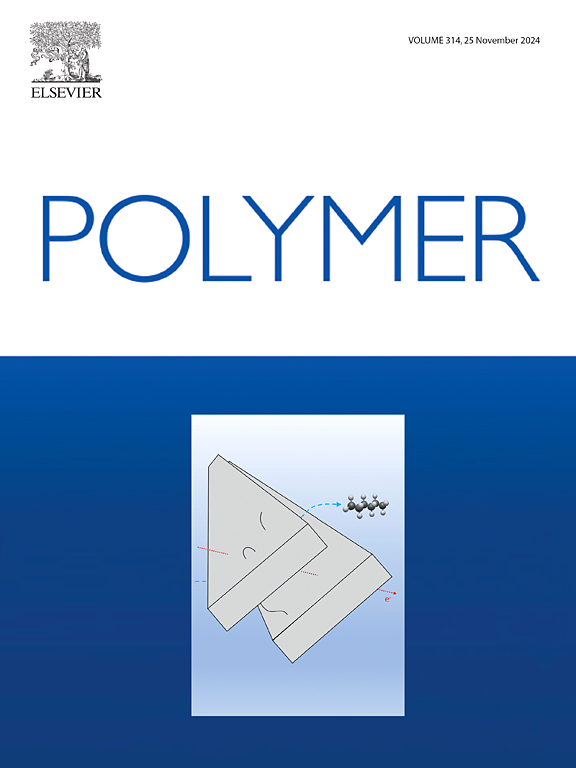Low non-radiative recombination loss in organic solar cells with 5,6-Difluorobenzo[c][1,2,5]thiadiazole based donor polymers
IF 4.5
2区 化学
Q2 POLYMER SCIENCE
引用次数: 0
Abstract
Non-radiative recombination loss (ΔEnr) constitutes the primary component of energy loss (Eloss) in organic solar cells (OSCs). Reducing Eloss is critical for enhancing OSC performance, yet developing simple, cost-effective polymer donors capable of achieving high-efficiency OSCs with minimal Eloss remains a significant challenge. In this study, four 5,6-difluorobenzo[c][1,2,5]thiadiazole (ffBT)-based copolymer donors are successfully synthesized via straightforward reactions. By modulating the molar feed ratio of ffBT units during polymerization, the solubility and crystallinity of the polymers are optimized. When the molar feed ratio is set to 25 %, the terpolymer D2 achieves an optimal balance between solubility and crystallinity, leading to a better film morphology in the active layer. Consequently, the D2:Y6-based devices demonstrate efficient charge transfer, effective charge generation, and suppressed charge recombination, yielding a highest short-circuit current density of 23.03 mA cm−2 and power conversion efficiency of 12.79 % among four OSCs. Remarkably, devices fabricated with these donors and the Y6 acceptor all exhibit a low ΔEnr of approximately 0.190 eV. This work highlights that combining ffBT with terpolymerization offers a promising strategy for designing simple yet high-performance polymer donors, while providing critical insights into minimizing ΔEnr in OSCs.


基于5,6-二氟苯并[c][1,2,5]噻二唑的有机太阳能电池低非辐射重组损失
非辐射复合损耗(ΔEnr)是有机太阳能电池(OSCs)能量损耗(Eloss)的主要组成部分。减少损耗对于提高OSC性能至关重要,但开发简单、经济的聚合物供体,以最小的损耗实现高效的OSC仍然是一个重大挑战。本研究通过简单的反应成功合成了4个5,6-二氟苯并[c][1,2,5]噻二唑(ffBT)基共聚物给体。通过在聚合过程中调节ffBT单元的摩尔投料比,优化了聚合物的溶解度和结晶度。当摩尔进料比设置为25%时,三元共聚物D2在溶解度和结晶度之间达到最佳平衡,导致活性层中的膜形态更好。因此,基于D2: y6的器件表现出高效的电荷转移、有效的电荷产生和抑制的电荷重组,在4个OSCs中产生最高的短路电流密度为23.03 mA cm-2,功率转换效率为12.79%。值得注意的是,用这些供体和Y6受体制造的器件都表现出约0.190 eV的低ΔEnr。这项工作强调,将ffBT与三元聚合相结合,为设计简单而高性能的聚合物供体提供了一种有前途的策略,同时为最小化osc中的ΔEnr提供了重要见解。
本文章由计算机程序翻译,如有差异,请以英文原文为准。
求助全文
约1分钟内获得全文
求助全文
来源期刊

Polymer
化学-高分子科学
CiteScore
7.90
自引率
8.70%
发文量
959
审稿时长
32 days
期刊介绍:
Polymer is an interdisciplinary journal dedicated to publishing innovative and significant advances in Polymer Physics, Chemistry and Technology. We welcome submissions on polymer hybrids, nanocomposites, characterisation and self-assembly. Polymer also publishes work on the technological application of polymers in energy and optoelectronics.
The main scope is covered but not limited to the following core areas:
Polymer Materials
Nanocomposites and hybrid nanomaterials
Polymer blends, films, fibres, networks and porous materials
Physical Characterization
Characterisation, modelling and simulation* of molecular and materials properties in bulk, solution, and thin films
Polymer Engineering
Advanced multiscale processing methods
Polymer Synthesis, Modification and Self-assembly
Including designer polymer architectures, mechanisms and kinetics, and supramolecular polymerization
Technological Applications
Polymers for energy generation and storage
Polymer membranes for separation technology
Polymers for opto- and microelectronics.
 求助内容:
求助内容: 应助结果提醒方式:
应助结果提醒方式:


